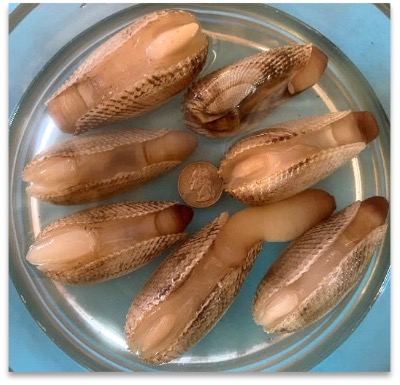
The potential for commercial aquaculture development of the angelwing clam Cyrtopleura costata, a burrowing bivalve found along the US Atlantic and Gulf of Mexico coasts, was reexamined. Studies conducted in the 1980s demonstrated angelwings could be spawned using hatchery methods similar to those for commercial bivalve species. Preliminary results also indicated angelwings grow rapidly and could reach a potential harvest size in six months. However, the lack of economical production methods and harvesting techniques stymied further consideration of angelwings as an aquaculture candidate species. Despite its excellent flavor and attractive shell, another drawback was its short shelf life as most bivalves until recently were marketed as live shellstock. In the past two decades, aquaculture of the geoduck Panopea generosa, North America’s largest phollad clam, has advanced due to its high market value. By adapting methods developed for geoduck aquaculture, it was hypothesized that reliable production of the angelwing clam could be achieved.
In this study, adult angelwing clams were sourced from local populations in Cedar Key, FL and successfully spawned and reared in a commercial hatchery with similar results as previous studies. A notable exception was that pediveligers set equally well in sand substrate and without substrate. Post-set (approximately 2-3 mm shell length, SL) were nursed in sand-filled tanks reaching 10.8-11.7 mm SL in 14-22 days, at which time juveniles were of the size to be planted in the field. Several field and land-based culture methods were evaluated: PVC tubes under bottom nets, submerged bottom cages, modified bottom bags, and raceway tanks. After 23-24 weeks (six months from spawning), angelwings reared in the field (bottom plant) averaged 61.6+7.0 mm SL and 24.1+7.4 grams in total weight, whereas angelwings in raceway tanks averaged 46.3+3.4 mm and 5.0+1.9 grams, respectfully. Although survival in the bottom plant was low (16.5%), size distribution of recovered intact valves (shells) was similar to harvested live angelwings. Mortalities may have been related to buryment; survival could have exceeded 40% if angelwings had been harvested even one month earlier. With improved management practices, the bottom plant is a potentially viable growout method.
Two post-harvest processes were tested at a commercial processing facility: modified atmosphere packaging for live product and partially cooked, flash frozen in vacuum packed bags. Preliminary evaluation of these processes for shelf life, breakage, taste, and appearance was conducted and compared to live shellstock product, which had a shelf life of two days in refrigerated storage. In terms of overall marketability, live was considered the best way to market, which would require angelwings to be held in seawater during the entire distribution channels. Post-harvest treatments used commercially for hard clams proved to be of no benefit for angelwings.
For more information on project results, view the final report below.
Aquaculture Potential of the Angelwing Clam: The Gulf Geoduck? (pdf, 1.6MB)
Sturmer, L., Mooks, S., and Maynard Sr., M. 2021. Final report to the Gulf States Marine Fisheries Commission, 17 pp.
Project results were also presented at a national meeting. The presentation can be viewed in PDF and video format.
Aquaculture Potential of the Angelwing Clam: The Gulf Geoduck? (pdf, 1.9MB)
Sturmer, L., Simon, N., and Markham, R. 2021. Presented at the 113th Annual Meeting of the National Shellfisheries Association (virtual conference).
Leslie Sturmer, University of Florida/IFAS Extension
Scott Mooks, Wray Clam Wranchos Hatchery
Mark Maynard Sr., Southeastern Seafood Products
Gulf States Marine Fisheries Commission, Marine Aquaculture Pilot Projects, 2020